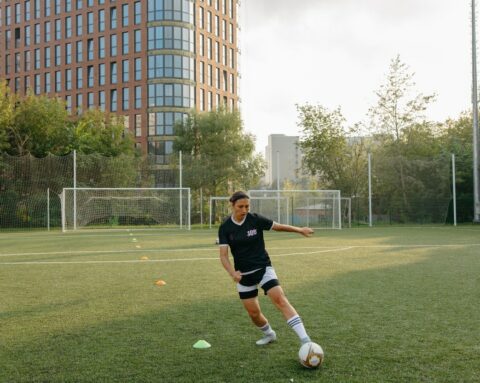Osgood Schlatter’s Disease is described as an inflammation of the bone at the top of the tibia, where the tendon from the patella attaches. The injury is quite common and is most often seen in adolescents or children. It is considered an overuse knee injury.
Osgood Schlatter’s Disease most commonly appears in adolescents who are very active during a time of growth. There is a two year period where adolescents grow most sharply and this is when they are most susceptible.
The disease is most commonly seen in boys but will affect both genders – particularly those with tight thigh muscles. The condition is most prevalent in girls aged 8-13 and boys aged 11-15.
Playing sports such as basketball, gymnastics, ice skating, soccer, dance and others that involve repetitive jumping and running will cause you to be at risk.
Symptoms
Here are some symptoms that may appear from Osgood Schlatter’s Disease:
– Pain from direct kneeling contact or pain experienced during exercise
– Weakness can be seen in the quadriceps
– Localised pain and swelling around the patella tendon
-You may experience pain when squatting, kneeling or doing stairs
-You may notice a tender lump which is caused by a normal development outgrowth of the bone
Osgood Schlatter’s is caused by repetitive quadricep contractions that disrupt growing bones. There are four stages of bone development as a child grows:
The first stage is where the muscles and connective tissues attach is cartilaginous. The second stage is where the officiating of the cartilage begins
The third stage marks the unity of the proximal tibial epiphysis with the tibial apophysis. Finally, the growth plates will fuse and the bony stage has been achieved!
Osgood Schlatter’s is caused by repetitive quadricep contractions that disrupt growing bones. There are four stages of bone development as a child grows:
We also often see Osgood Schlatter’s Disease caused by a lack of growth in the quadriceps compared to growth in the femur. When your child has a growth spurt their muscles will be unable to keep up with the lengthening of the femur, which results in an increased tensile force on the tibial tuberosity.
Children are most susceptible to Osgood Schlatter’s Disease when their bones are in the second stage that we mentioned previously.
Diagnosis:
To diagnose Osgood Schlatter’s Disease we will base our determination on clinical findings. In almost all cases, radiographic examinations will be performed on both knees to rule out the possibility of other injuries such as infections, fractures or ruptures.
Following this procedure, a diagnosis will be confirmed through clinical correlation to ensure we take the maximum amount of care with diagnosing the condition.
So.. What Else Do I Need To Know?
Severe cases of Osgood Schlatter’s Disease require management by professionals to avoid damage to the growth plate. However, the good news is that mild cases of the disease can heal in days or weeks.
The condition can lead to an avulsion fracture of the patella tendon which can make it difficult to run or walk. Thankfully, utilising physiotherapy is an effective way to manage Osgood Schlatter’s Disease!
One major positive of Osgood Schlatter’s Disease is that it responds well to non-surgical myotherapy! 90% of people treated with myotherapy have seen positive results over a 12-24 month period where we can come to a complete resolution of the condition!
One of the key aspects in managing Osgood Schlatter’s Disease is ensuring you are getting adequate rest. Your myotherapist will be able to guide you on whether you should continue playing sport or manage your workload with respect to the severity of your injury. This is one of the best ways to ensure your pain is lessened and your recovery is on track.
Complete recovery from Osgood Schlatter’s Disease occurs when the tibial growth plate is closed. It is not uncommon for patients to experience long-term discomfort when kneeling so avoiding bone enlargement permanence is important. Whilst Osgood Schlatter’s Disease can indeed last for months, most people will recover well with conservative treatment!
Make sure to discuss your condition with your doctors and trained myotherapist to receive the best possible advice for your situation!






